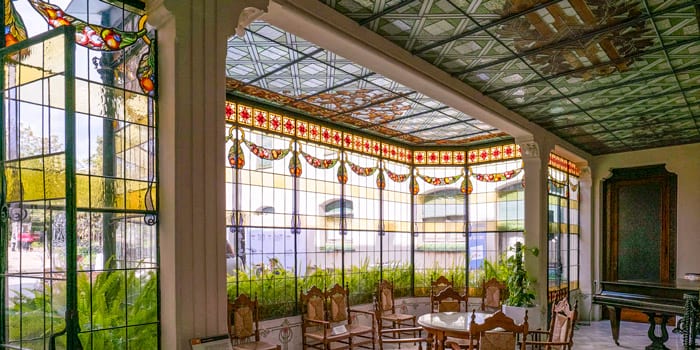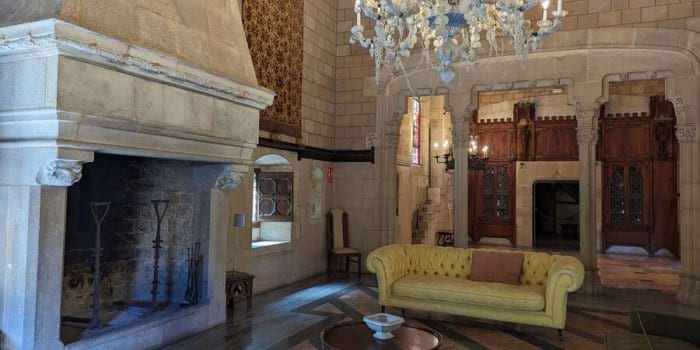
Casa Alegre de Sagrera, Terrassa

Santa Florentina Castle, Canet de Mar

Masia Freixa, Terrassa

Palau Maricel, Sitges

Gaudí Crypt, Santa Coloma de Cervello
Modernisme: 7 must-sees near Barcelona
If there is an art movement linked to Barcelona, it is Modernisme. As a symbol of flamboyance and modernity for the bourgeoisie of that time, we still have many examples of this aesthetic revolution that emphasised curved shapes and highlighted the importance of detail and craftsmanship.
Barcelona is the cradle of this avant-garde art. Furthermore, in the different regions of Barcelona and very close to the city, there are also great gems that have largely gone unnoticed, perhaps because they are not on Passeig de Gràcia. If you have not visited them yet, you should do so as soon as possible.
Masía Freixa and Terrassa
Terrassa is the capital of industrial tourism. The plethora of textile factories in the late 19th century brought economic prosperity to the city that showed in its architecture. You will find a steam engine or a chimney in every corner. However, there are three things you cannot miss: the National Museum of Science and Technology of Catalonia, the Casa Alegre de Sagrera and the Masia Freixa by architect Lluís Muncunill. A former factory that was turned into a home, it currently houses the tourist office. It is a good place to start your tour of Terrassa, and they also offer guided tours inside the building.
Artigas Gardens
When Gaudí visited the Berguedà region, he also left his mark. The Artigas Gardens were a gift to his host, the owner of the Asland cement factory. It is perhaps the architect's least-known work in Catalonia, but it is a perfect example of how art blends with nature. A great experience that you can round off with a trip on the Cement Train.
Santa Florentina Castle and the Domènech i Montaner House Museum
Canet de Mar is home to several modernist gems, as the fishing village was the birthplace of Lluís Domènech i Montaner. Santa Florentina Castle is made for daydreaming. The castle was created from the refurbishment of an old medieval house. The result is so stunning that several episodes of Game of Thrones were filmed there. The village is also home to the Domènech i Montaner House Museum. We recommend checking the programme before you go, as there are special activities every weekend.
Gaudí Crypt
Where the Sagrada Família originated. Where it all began. A small church, which was supposed to be just the crypt, but remained unfinished. This is where Gaudí tried out the main architectural innovations that he would later apply to the Sagrada Família. A gem where light and shapes convey an aesthetic experience. As well as being a World Heritage Site. Take the opportunity to visit the charming Colònia Güell which surrounds it.
Casa Coll i Regàs and Mataró
Following in Gaudí's footsteps, you may not know that his first work is located in Mataró. Nau Gaudí is an example of functionality, simplicity and elegance. A warehouse with 13 parabolic arches that convey a spacious and open feel, a true innovation in the industrial architecture of that time. Without leaving Mataró, the second visit you cannot miss is Casa Coll i Regàs. Harmony made into a home. Its walls and decorations are visual symphonies. Tucked away in the middle of the city, it may go unnoticed from the outside, but its interior is a little secret you will be keen to discover.
Cau Ferrat and Maricel
This list would not be complete without Sitges and its museums. Two examples of first-rate Modernisme, both for their buildings and for what you find inside. Cau Ferrat is one of the temples of Modernisme, founded by the artist Santiago Rusiñol, while the Maricel Museum also features works from the period, although the visit is a journey through the history of art from the Middle Ages to the 20th century.
There are many other Art Nouveau buildings and monuments in the regions of Barcelona: You can enjoy the summer vacation architecture on Illa Raspall in La Garriga or in Cardedeu, the tile factory in Esplugues del Llobregat, the Art Nouveau Winery in Sant Cugat, the Palau Güell in Barcelona, the Centre Jujol - Can Negre in Sant Joan Despí, the Casa de les Aigües in Montcada i Reixac and the Cerdanyola Art Museum. Virtually every town and city boasts examples of this movement, which has become a hallmark of the region.







